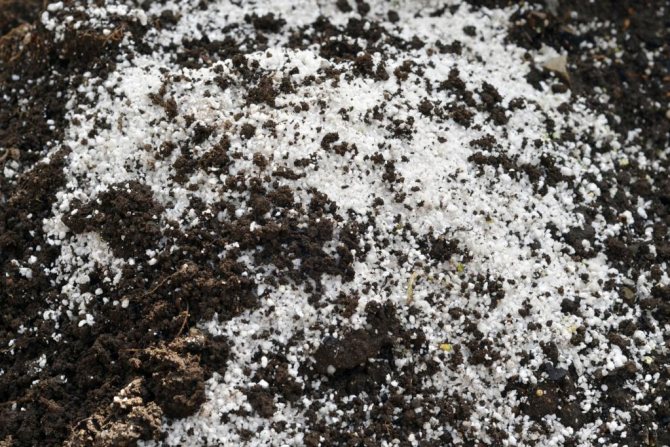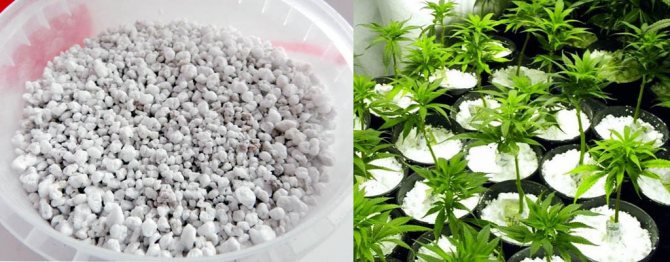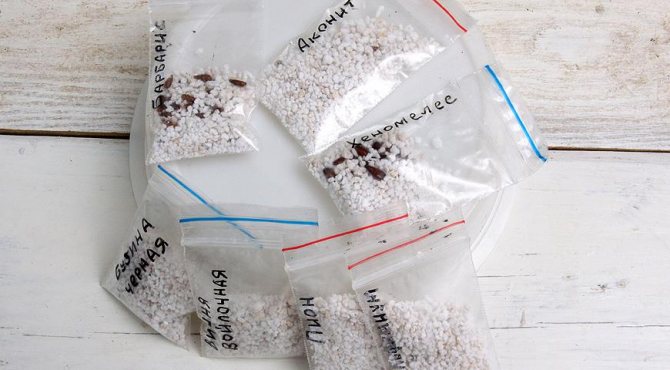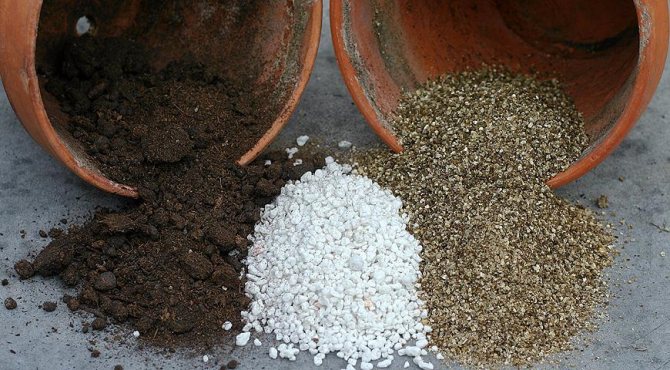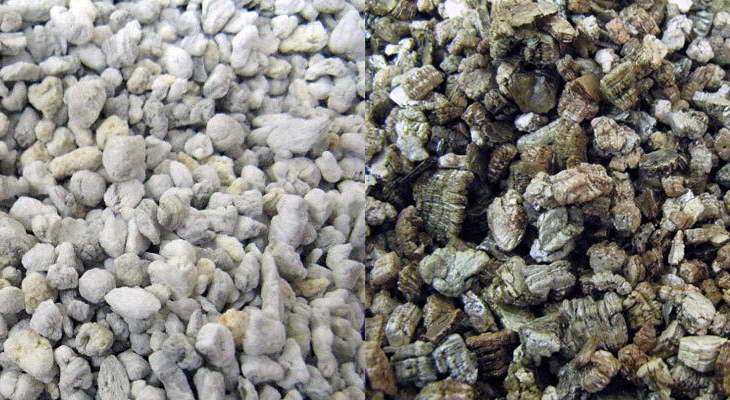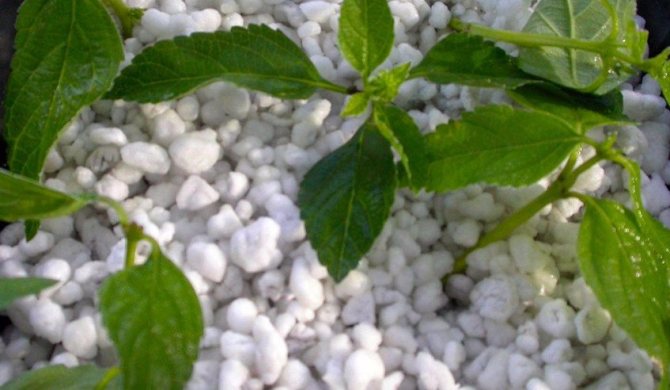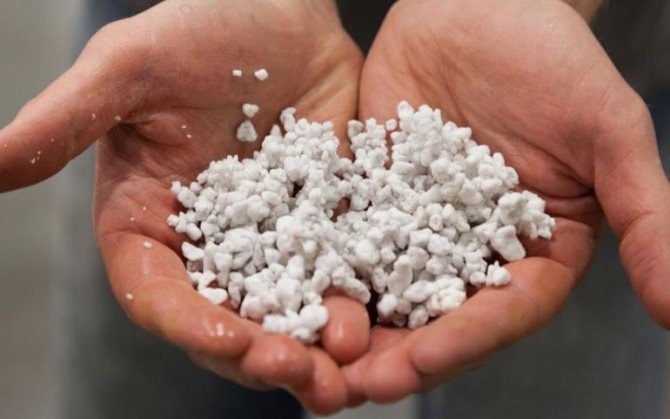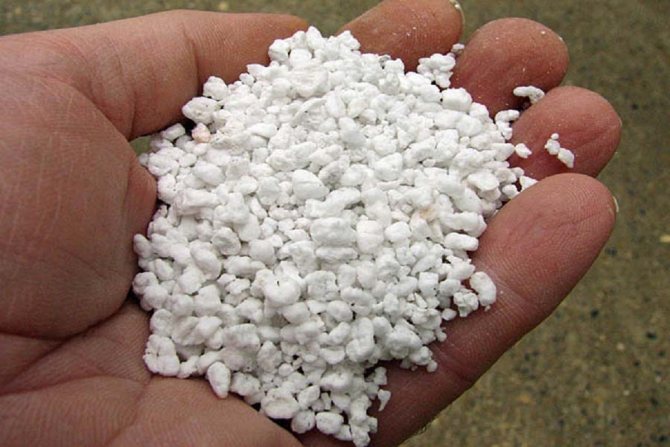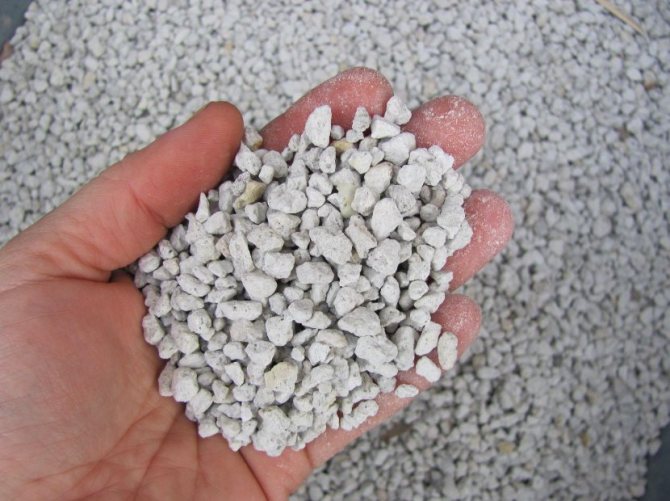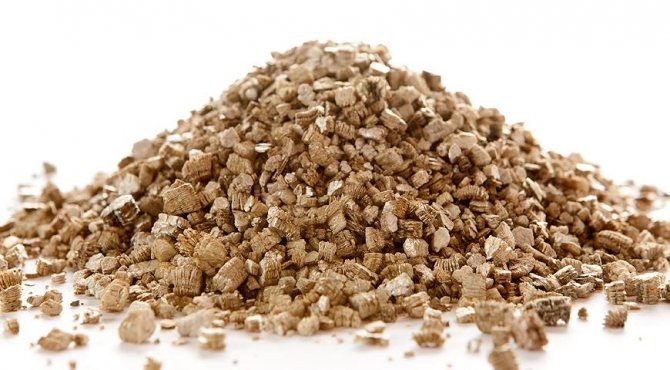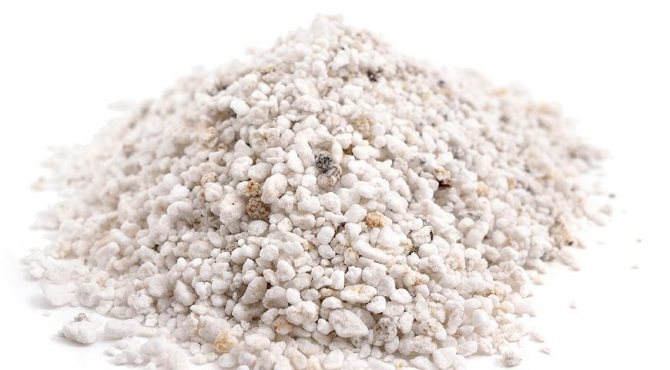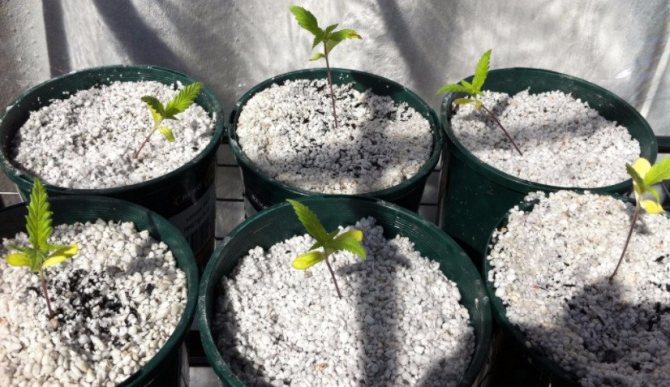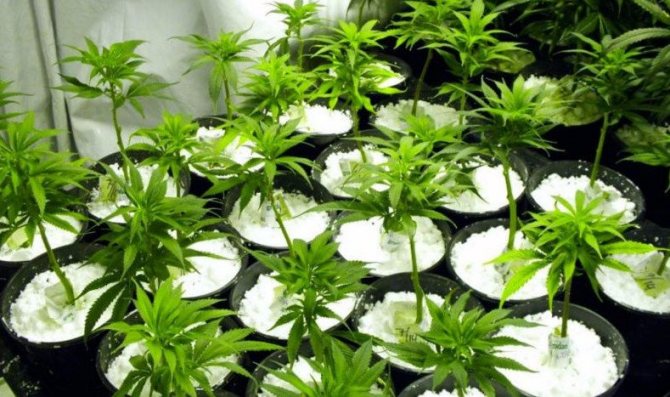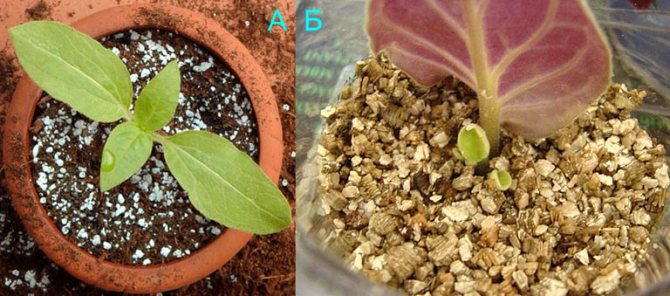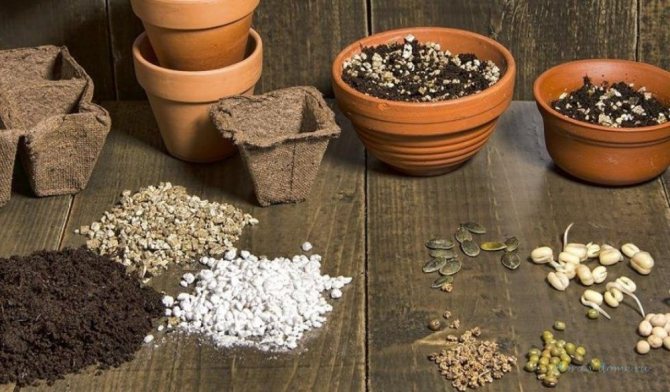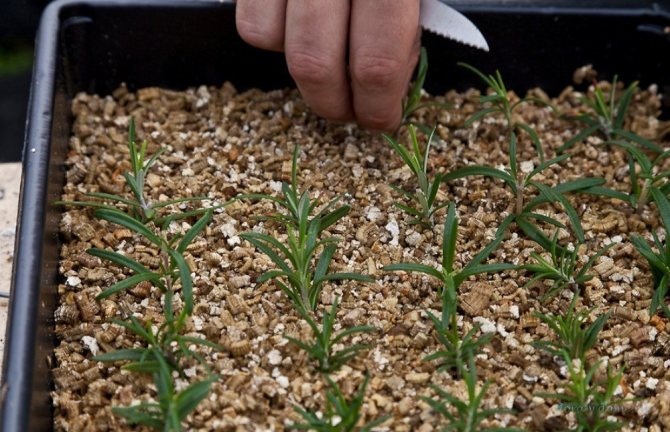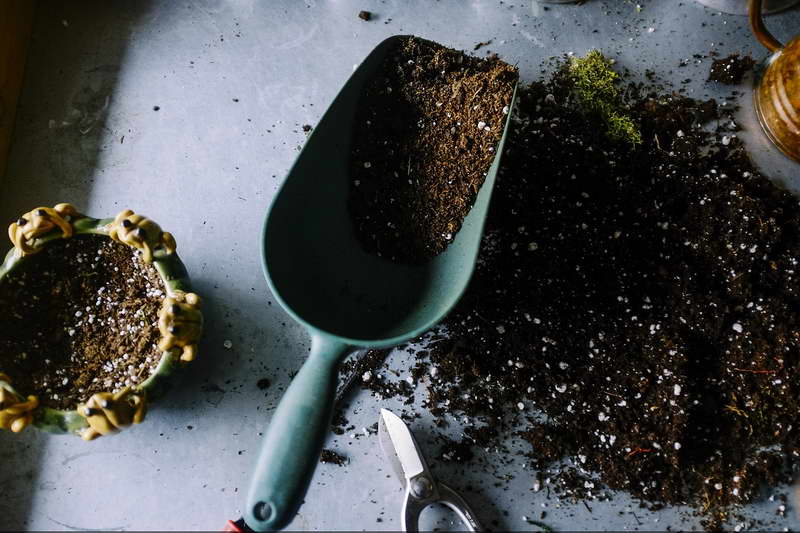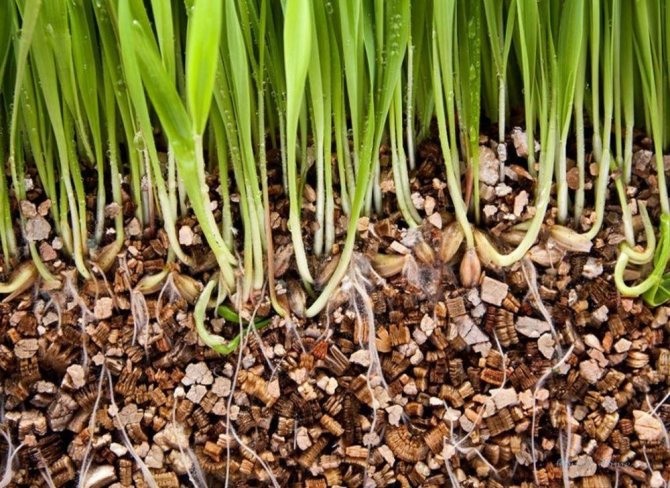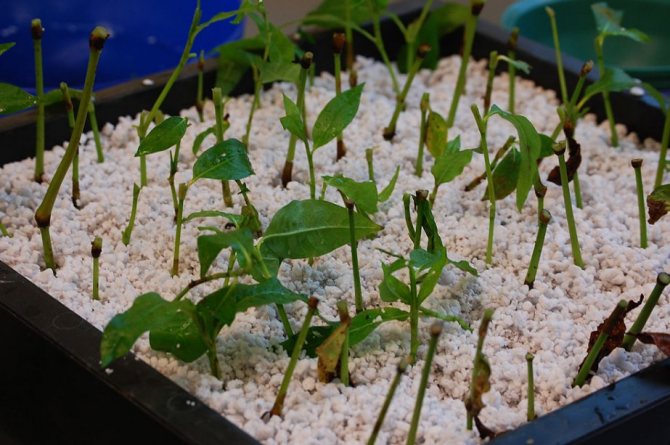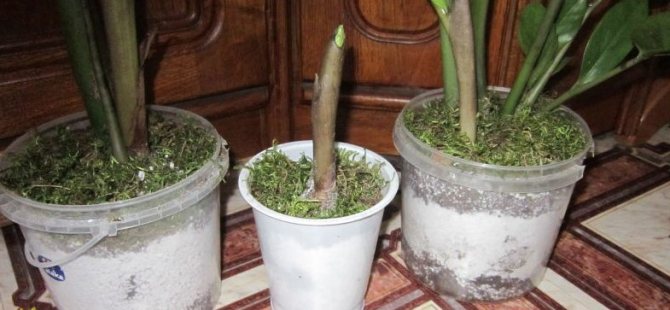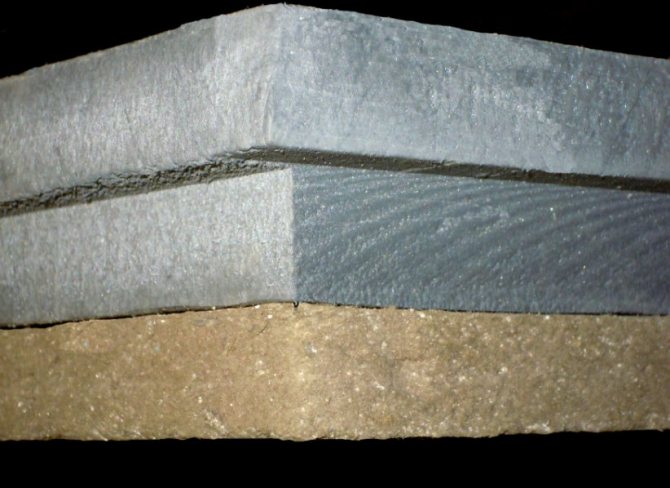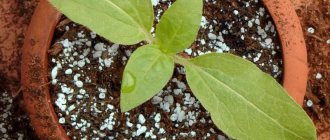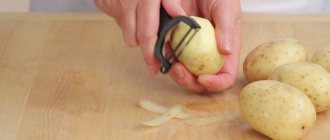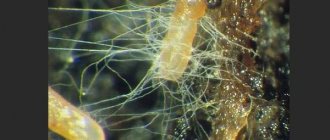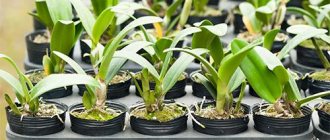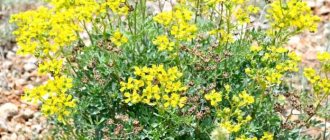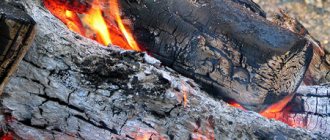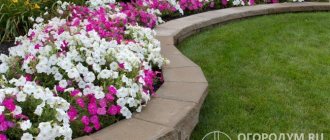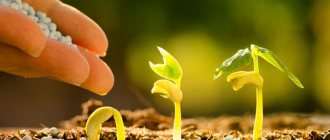Perlite is a volcanic rock, or, more correctly, a glass of volcanic origin, i.e. natural material. When heated to a certain temperature, it is able to increase in volume by 4-20 times relative to the initial one. Metamorphosis occurs due to the content of bound water in perlite in an amount of 2-6%.
If the perlite reaches 870 ° C, it will burst like popcorn. When the material is heated strongly, water turns into bubbles and is released from the glassy but soft particles. Perlite is chemically inert, with a pH of 7. It can be considered a special form of glass of natural origin.
Agroperlite: what is it and what is it for
The mineral additive agroperlite is obtained from perlite, a volcanic rock with a characteristic small rounded structure, along which it is divided into separate nucleoli, which outwardly resembles untreated pearls. Hence its name: "perle" in French means "pearl".
Perlite is formed from volcanic glass of obsidian by hydration with groundwater. Obsidian, in turn, is formed at the points of contact of the edge of the lava flow as a result of its rapid cooling upon contact with the earth's surface. It is distinguished from other rocks of volcanic origin by the presence (more than 1%) of constitutional (bound) water, which is not present in free form, but is released when heated. The main part of its chemical composition is silicon dioxide (65%) and aluminum oxide (about 16%). It also contains water and oxides K, Na, Fe, Ca, Mg.
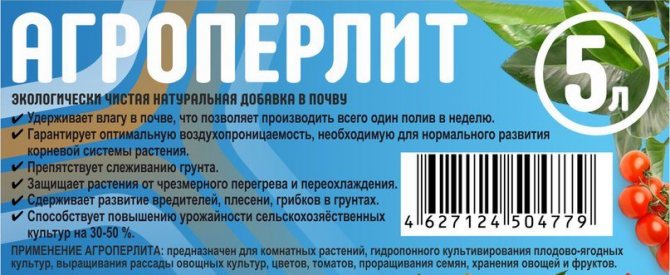
Perlites are distinguished by texture and color. Based on textural features, 4 varieties are distinguished: pumiceous, brecciated, massive, banded.
The color of perlite depends on the impurities included in it and can be of different shades of black, green, brown, red-brown, white. By types, perlite is divided into:
- resinous-stone - homogeneous, without impurities;
- spherulite - with feldspar inclusions;
- obsidian - with inclusions of volcanic glass;
- glassy - with inclusions of sand and borax;
- other.
The presence of constitutional water gives perlite the ability to swell when heated above 800 ° C and increase in size by more than 20 times.
Expanded perlite is a porous, free-flowing, light, loose and durable environmentally friendly organic material that is used in various fields of human activity, mainly in construction and plant growing.
general description
Perlite is a volcanic rock. That is, a natural formation that can be found quite often in the mountains. It is a peculiar form of volcanic glass that was very quickly heated to 900 degrees. As a result, the perlite swelled like popcorn.
Plant perlite, or agroperlite, is a substrate that can be used ready-made or mixed with other ingredients. Its use significantly increases the efficiency of farming.
Advantages and disadvantages of agroperlite when used in agricultural technology
As mentioned above, agroperlite used in crop production is thermally processed expanded perlite, presented in 5 fractions.Each of them is suitable for specific purposes. The largest fraction is the first, the size of a small coin, the smallest is the fifth, the size of a large grain of sand.
Agroperlite is widely used in crop production due to the following advantages:
- High moisture content. It is able to absorb a volume of liquid 4 times its own weight, and then slowly release it into the soil, protecting the plants from overflow.
- Biological resistance. Does not decompose, does not rot under the influence of microorganisms and does not attract rodents and insects.
- Chemical inertness. Does not react with alkalis and weak acids.
- Ecological cleanliness. It is a sterile material, there are no heavy metal salts and toxic substances in it.
- Heat insulating properties. Agroperlite reflects ultraviolet rays, thereby protecting plant roots from overheating and hypothermia.
- Durability. The shelf life of this substance is not limited and depends only on the conditions created for the preservation of its free-flowing, loose structure. It must be stored in a dry room with a relative humidity of no more than 60%.
However, do not think that this material is perfect. Along with the advantages, its use also has disadvantages:
- Small fractions of agroperlite are very dusty, getting into the eyes and lungs, which can adversely affect human health. To avoid this, mineral chips are moistened with water from a sprayer before use, and all work with it is carried out in a mask or respirator and goggles. If dust does get into your eyes, rinse them with copious amounts of water.
- The cost of this material is high, so it is not economically feasible to use it in large volumes in horticulture. Moreover, there are cheap baking powder on sale that can replace perlite.
- Agroperlite is a fairly rare additive. This is used by unscrupulous manufacturers and sellers and, under the guise of natural material, sell counterfeits similar to it in appearance, but artificial and not possessing its properties.
- The white color of the mineral granules complicates the identification of such pests in the soil as root and mealybugs, mushroom gnat larvae and some others.
- When growing plants using hydroponics and watering them with hard water, the substrate becomes alkalized. An alkaline environment blocks the access of nutrients to the root system of plants, and their growth slows down.
- Having a positive electric charge, perlite does not participate in the process of ion exchange, and therefore in plant nutrition, since it is not able to retain the positive ions of fertilizers.
It is strongly discouraged to fertilize perlite with calcium preparations. Together they contribute to the alkalization of the acidic environment, which negatively affects the growth of plants.
What is perlite for plants for?
It is more correct to call perlite for plants agroperlite. Perlite rock is expanded in a special way, using a special technology. Then the material can be used to grow indoor flowers. Initially, the color of the rock is black, brown or even green, after processing it turns into agroperlite - white porous particles. It is mixed into the soil to ensure looseness, improve air and moisture exchange, and improve quality characteristics in general.
Perlite properties are actively used in floriculture.
Thanks to perlite, an optimal air-water balance is established in the soil, the earth is not compacted and remains crumbly. In heavy soils, it increases aeration, and in light soils, it adds moisture retention properties. The additive is able to lower the acidity of the soil, slow down its salinization, and prevent waterlogging.
For plants "living" in pots, flowerpots and other containers, it is important to keep the earth lump breathable. This is especially true for adult crops that are not transplanted every year.Indoor plants with the help of perlite provides excellent drainage, the roots more freely and evenly fill the volume of the pot. Good aeration promotes active and full development, regular flowering. Having received sufficient oxygen, the flowers "breathe" completely.
Perlite actively absorbs moisture, increasing in volume by 4 times... This happens after watering. The particles then gradually release moisture to the plant's root system. They are like vessels with water, each of which is emptied one by one. First, the water is consumed by pieces located near the roots and so on. By the way, if you overdo it with fertilizers, perlite will absorb the extra dose and will gradually feed the plants.
If the top layer of the soil dries up, it will never become clogged with a hard crust that blocks the access of oxygen. Perlite will begin to pick up moisture from the bottom, delivering it to the roots.
Perlite helps to maintain a stable earthen ball temperature, thereby protecting the plant from overheating or hypothermia. Perlite is reflective in the top layer of the soil. Ultraviolet rays bounce off the material and only heat the reverse side of the sheet. The soil remains at normal temperature and the roots do not dry out.
The heat-conducting properties of the soil are in direct proportion to its density. The higher it is, the faster the heat transfer. But the loose soil heats up slowly and evenly, it also cools down, protecting the root system from overheating / freezing.
Perlite disintegrates after 3-4 years, this is facilitated by loosening and digging the soil.
The use of agroperlite in gardening and indoor floriculture
From the above advantages of agroperlite, it becomes clear what it is for. Thanks to them, its possibilities of application in various fields of plant growing, especially indoor floriculture, are quite extensive.
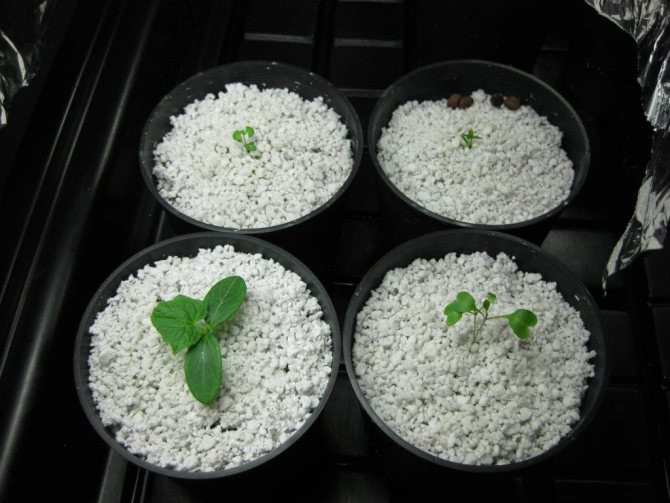

Growers use agroperlite for the following purposes:
- Rooting cuttings and germinating seeds. Seedlings, when grown in agroperlite, are less likely to be exposed to fungal diseases, and cuttings rooted in moist perlite do not rot. It is important to take into account that there are no substances useful for plants in the breed itself. They need to be watered with aqueous solutions of complex fertilizers, and to create the necessary microflora, bacterial preparations should be introduced into the substrate. In both, Ca should not be present, otherwise the neutral pH of the agroperlite reaction will turn into alkaline.
- As a component of the planting mixture. To improve the quality characteristics, the substrate is mixed with mineral chips in a ratio of 60/40. This significantly improves soil aeration, prevents clogging and caking, and does not form a crust on the soil surface. And since perlite has thermal insulation properties, it protects plant roots from temperature extremes: they do not overcool or overheat. The moisture content of the additive is also important. One kilogram of perlite absorbs up to four liters of water, along with the beneficial substances it contains, and gradually gives them to the plant. As a result, the number of irrigations decreases and their quality increases: fertilizers are not washed out, moisture losses from drainage and evaporation are reduced, plant roots do not rot from overflow and stagnation of moisture, the soil is moistened evenly.
- Even distribution of seeds during sowing. For this purpose, use a fine fraction of perlite, mixing it with the seed. After sowing, soil is sprinkled on it, thereby protecting it from drying out and waterlogging. Since volcanic glass partially transmits light, it is allowed to sprinkle it even on seeds with increased photosensitivity.
- Increase of air humidity in the room.During the heating season or in extreme heat, agroperlite of large fractions soaked in water is laid out on plates or trays near indoor plants. This gives a longer lasting effect than spraying, as water evaporates from its surface slowly and gradually.
- Hydroponics. When growing plants hydroponically on nutrient aqueous solutions, agroperlite is used both independently and in a mixture with any substrate. Whether it can be used independently is determined based on the characteristics of the culture grown and the quality of the water (it should not be hard).
- Drainage. Agroperlite of large fractions is used as a drainage layer at the bottom of a flower pot or any other planting container. For this purpose, you can take it both in pure form and in a mixture with expanded clay in a 50/50 ratio.
- Mulching. It is also better to use coarse crumbs as mulch. It prevents the appearance of a crust on the soil, perfectly protects the soil from the effects of pests, and the roots of plants from drying out and waterlogging. When mulching garden plants per 1 sq. meter is consumed from 5 to 9 liters of mineral fertilizing.
- Storage of planting material. Bulbs, tubers, rhizomes are perfectly preserved in perlite, do not lose their vitality, do not rot, do not germinate prematurely and subsequently give strong shoots. They are placed in boxes, in layers so that they do not touch each other. Each layer is sprinkled with a layer of dry mineral chips 2-7 cm thick, depending on the size of the planting material.
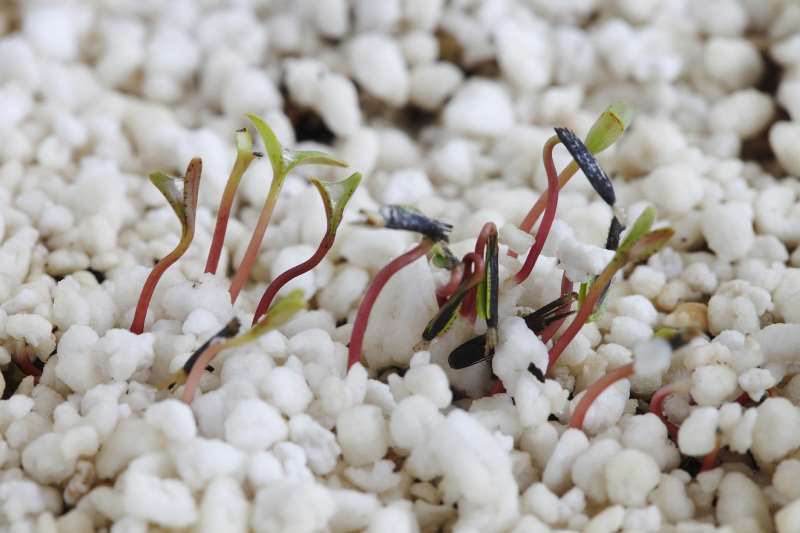

In hydroponic cultivation, agroperlite can be reused up to 20 times. Its structure degrades very slowly, due to which such a substrate practically does not lose its properties. Even coconut fiber and vermiculite cannot be compared with such characteristics with agroperlite.
Why is perlite useful for plants
Expert opinion on Perlite:
If you are not familiar with this substance, it is worth trying it for agricultural purposes. Expanded perlite has a wide range of useful properties for rooting, growing plants, storing fruit products. The use of agroperlite protects seedlings from the development of bacterial, fungal infections, and helps to accelerate growth processes. In a pot culture, it improves the quality of the earthy coma, reduces moisture evaporation, and prevents the formation of a surface crust.
Due to the above properties, agroperlite is used in the cultivation of various plants in order to improve the quality of soil mixtures before planting, transplanting crops. You can often hear the question - what is perlite for plants for?
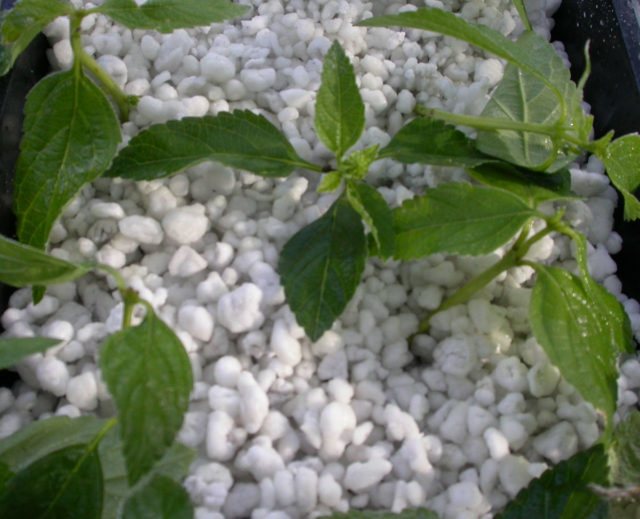

When growing various plants, perlite is used
With its help, you can avoid:
- tracking soil layers;
- development of deficiency of nutrients, microelements;
- the formation of a hard crust on the soil surface;
- improve hygroscopicity, air permeability of the soil mixture;
- in the case of use as drainage - acidification of the soil;
- the development of putrefactive reactions during rooting.
Tips from experienced growers
How much agroperlite to add to the substrate depends on the purpose of its use. So, for rooting cuttings, germinating seeds and growing seedlings with their subsequent transplantation to the street, it is better to add it to peat soil in a 1: 1 ratio. Greenhouses also use a mixture of peat and perlite in equal proportions with the addition of sand in a final ratio of 2: 2: 1.
To loosen and improve the properties of the soil, expanded perlite of medium and small fractions is mixed in half with the ground and laid half a meter deep. For too depleted soil, three parts of a mineral supplement are taken for one part of the land.
- As a substrate, agroperlite is well suited for growing strawberries and blueberries using the hydroponic method.Saplings take root well in such a substrate, since its use prevents waterlogging of the root system and the appearance of rot on it.
- Stratification in perlite or in its mixture with peat and sphagnum is a great way to bring seeds out of their dormant state and prepare them for sowing. Before the process, the seeds must be soaked. The terms, depending on the variety, can vary from several hours to several days. Then stratification in both cases is carried out according to the generally accepted scheme.
- Seedlings of peppers, cabbage, tomatoes and eggplants will feel better if perlite is added to the growing substrate instead of sand.
- For rooting of grape and pelargonium cuttings in perlite, it must first be moistened. Then a container with cuttings deepened by 7-10 cm is placed in a dark and dry place until the root strings appear.
- For petunias and most garden flowers, perlite is used as a loosening agent. To create the most favorable conditions, the flower additive should be taken in the smallest fractions.
- Agroperlite is an ideal material for roses, or rather for rooting them. It is better to do this in the fall during the period when flowering ends. To get a ready-made planting stalk, you need to remove the lower leaves and cut the upper ones in half. Cut the stem from the bottom obliquely and place it in a solution of a root formation stimulator for a day. Then place in a moistened substrate until roots appear.
- For indoor plants, perlite is often used as a drainage layer. A large fraction (it can be mixed with expanded clay) is poured onto the bottom of the pot with a layer 3-4 cm thick. On top of the mineral, the soil necessary for this plant is placed.
- Most soils are not suitable for both succulents and cacti, due to the inability to pass moisture through themselves. Adding a loosening agent to the soil will help increase its moisture holding capacity and aeration and maintain optimal conditions for growing such plants.
- Good soil aeration is important for violets. It allows their root system to breathe freely and prevents it from decay. The leavening additives help grow healthy and abundantly flowering bushes. For violets, they are used not only when planting seedlings, but also when rooting leaves. Transplanting seedlings into the ground is carried out when the roots grow long and strong enough.
- For orchids, you need a loose, breathable and moisture-absorbing substrate. The peculiarities of the root system do not allow orchids to develop normally if they are planted in ordinary soil. Therefore, perlite (or similar leavening agents) are essential for orchids. It can also be used as the main soil (hydroponics) if the flower aristocrat needs to revive the root system.
- The introduction of agroperlite into the soil before planting a lawn or garden flowers or in the fall into the ground before digging it prevents waterlogging.
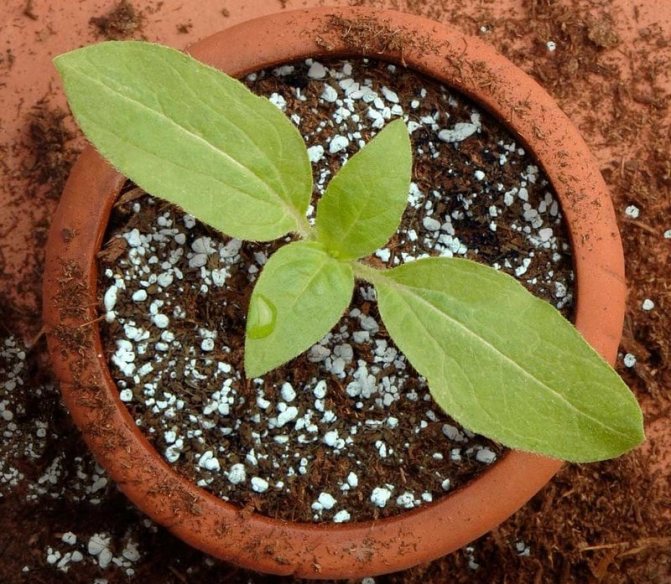

The shelf life of perlite is not limited. In addition, it can be used repeatedly, without loss of quality, after rinsing with plain soft water. Complete destruction of agroperlite grains (fraction 5 mm) occurs 3-4 years after application with repeated digging and loosening.
Structure
Today it is one of the most advertised baking powder that growers use to improve the lives of their green pets. It is a white, swollen granules that easily grind into dust.
The composition includes a number of substances, namely:
- Silicon and manganese dioxide.
- Aluminum and iron oxide.
- Potassium, magnesium and calcium oxide.
- Sodium oxide.
These components not only improve the physical properties of the soil, but also qualitatively affect its composition. Of course, granules are difficult to compare with fertilizer, but they also play a role.


Agroperlite: reviews
Most gardeners, florists and gardeners speak positively about this mineral supplement.Most often they buy it as a substrate for rooting cuttings and growing seedlings for open ground, as well as for home floriculture. In the reviews it is noted that the quality characteristics of the soil with the introduction of perlite into it are significantly improved. It becomes looser and more moisture-consuming, the frequency of watering decreases, water consumption is saved, plants are less susceptible to disease. This is a great way to grow crops with organic supplements with little effort. And its use in conjunction with similar materials (vermiculite, sphagnum moss) will make this process even more efficient.
Among the disadvantages of using agroperlite, there is a high price, which makes its use in large areas impractical. In these cases, it is better to replace perlite with budget loosening and adsorbing additives, such as vermiculite or zeolite. Many people notice the unscrupulousness of sellers who pass off cheap artificial fakes that are similar in appearance, but do not possess its properties as natural material.
What the product fractions look like
Processed perlite and vermiculite differ not only in properties, but also in appearance. Visually, perlite looks like small rounded pearls from cream to white. Coarse fractions are suitable for use as drainage, small ones are evenly mixed with the soil. For plants it has fractions from 0 to 5 mm perlite, photo for plants:
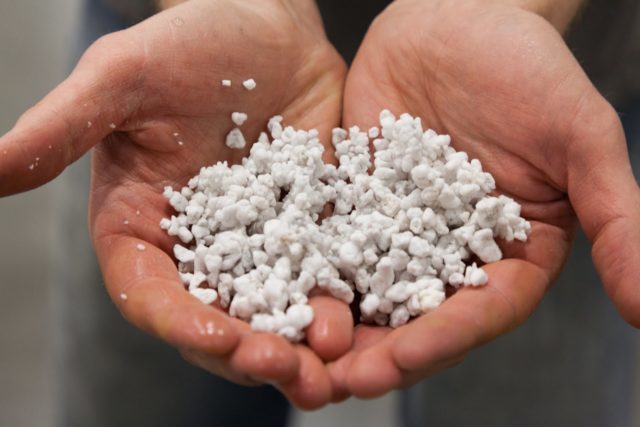

Large fractions of perlite are suitable for use as drainage
Vermiculite for indoor floriculture has fractions from 2 to 5 mm. Unlike perlite, it has a darker color spectrum. It has a golden, bronze or silver color. When heated, the substance takes the form of a caterpillar or a worm.
How to use
At first glance, this is a substitute for sand. This is true, but the use of the substrate is not limited to loosening the soil in flower pots, although this is a priority. Perlite allows you to solve several problems at once:
- Granules are widely used for seed germination.
- Is growing seedlings still challenging for you? Then try using a light perlite mixture.
- Creation of a drainage layer in pots.
- As a mulching material for garden plants.
- There are also alternative ways of using porous granules, which we will talk about today.
Mulching garden soil
This is the best way to prevent the formation of a hard crust on the soil. What is it for? An experienced gardener will immediately answer that such a formation prevents oxygen from reaching the roots, and also significantly speeds up the drying of the soil. It is not for nothing that loosening is called dry irrigation. But the grower usually just doesn't have enough time to break up the crust that forms after watering. To prevent this, the soil is mulched, that is, covered with a layer of humus or, in other words, mulch.
Perlite can also act as such. But its cost today can hardly be called low, therefore substitutes are most often used. If the choice fell on perlite, then do not forget that it is not recommended to bring it into the trunk circle. This place is left free and watering is carried out through it.
Expanded clay
Continuing the conversation about how to replace perlite for plants, one cannot but recall this universal material. There are several fractions, from 10 to 40 mm. Ground expanded clay is sold in a size of 0.3 mm and vaguely resembles coarse river sand. Lightweight, porous and clean, unique planting material. The porous structure allows a fairly large amount of water to be absorbed.
If you need drainage for indoor plants, then you can use gravel and crushed stone, broken clay shards. Coarse sand, foam and hydrogel are well suited for these purposes. You can even use ordinary stones from the yard.
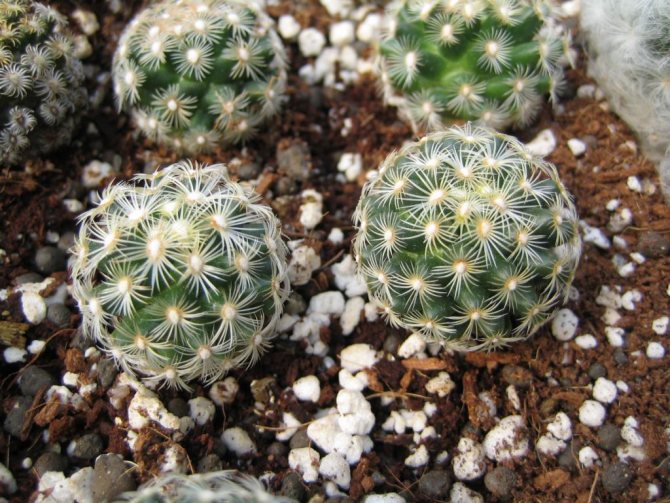

Soil improvement
The most common problem in most plots is dense, heavy soil. The only exception is sandy areas. But the excessive content of sand in the soil does not at all guarantee its lightness, since it cakes and becomes poorly suitable for growing plants.
The solution to the problem can be the introduction of perlite. The ratio of soil to porous granules is approximately 80/20. Don't forget to add fertilizer as well. The use of perlite makes the soil lightweight, which is important for the growth and development of crops.
If the plant is garden, then the use of porous granules will make it possible to improve the yield. To do this, dig a hole and remove excess soil from it. It is necessary to thoroughly mix the soil and perlite. Now you can plant the plant.
Since it is much easier to use perlite for indoor plants, and its consumption is small, growers use it for their decorative plantings more often than in the garden. To do this, you just need to mix the required amount of substrate with perlite and pour the mixture into the pot. The maximum amount should not exceed 1/3 of the total.
